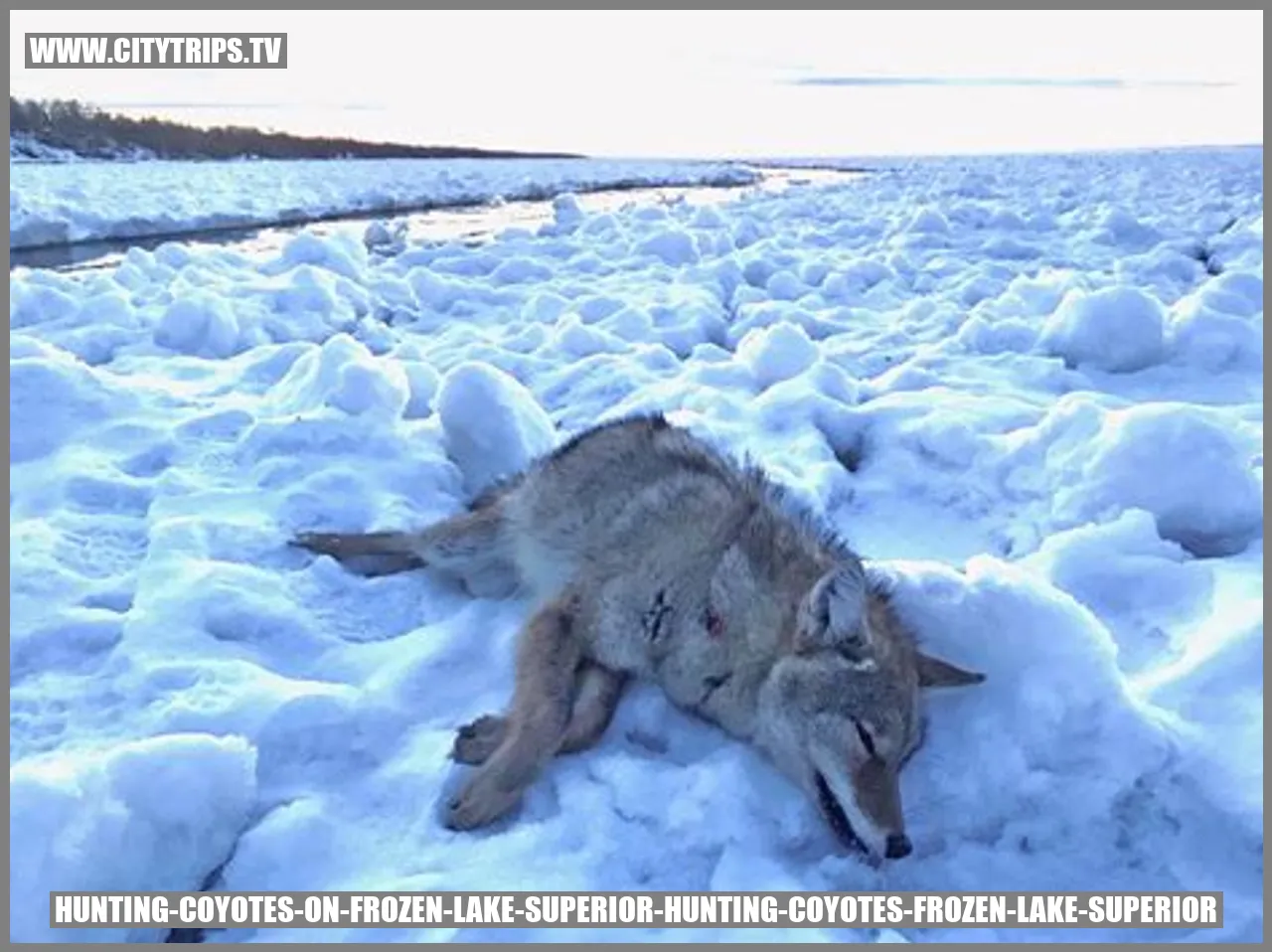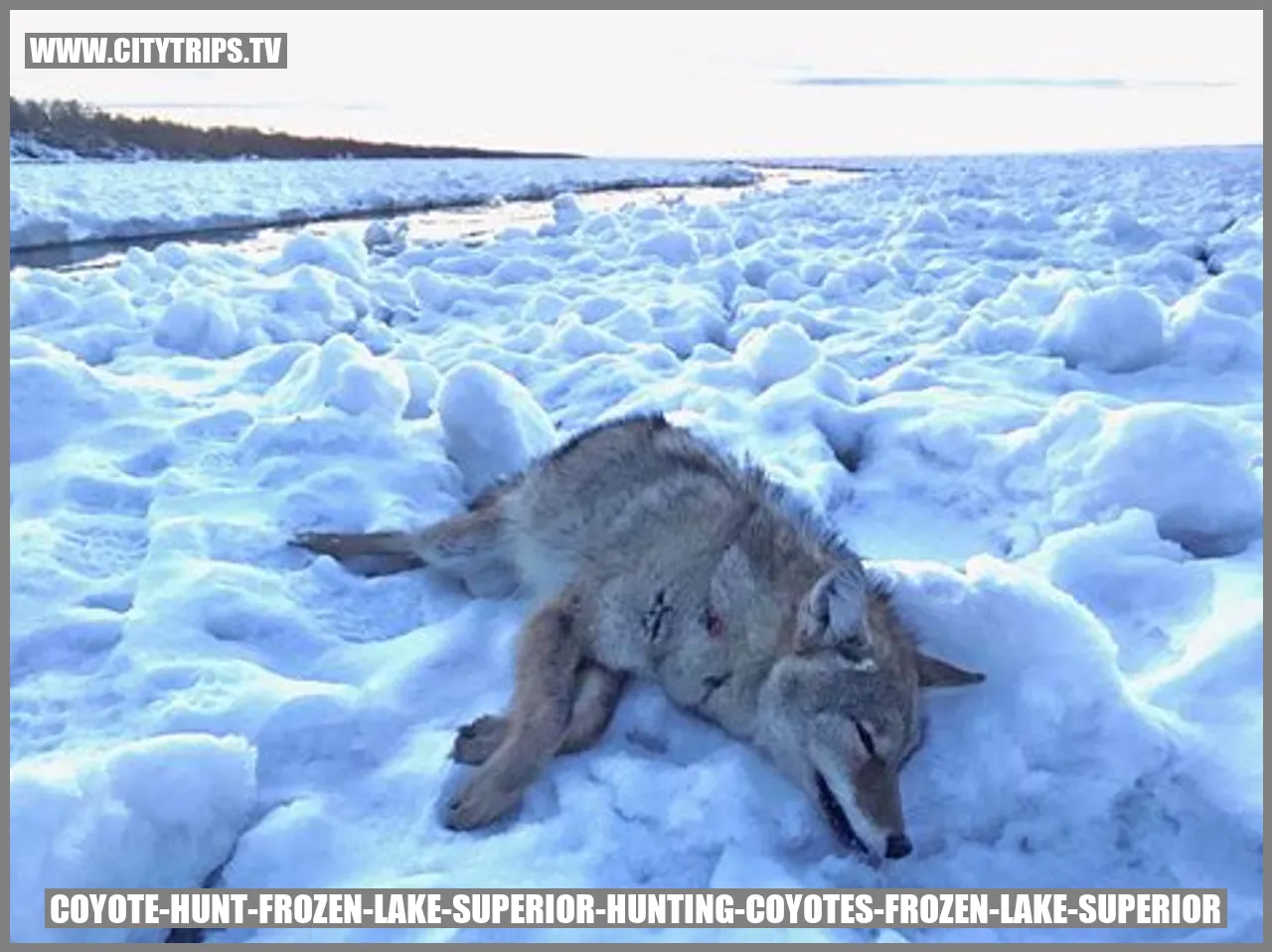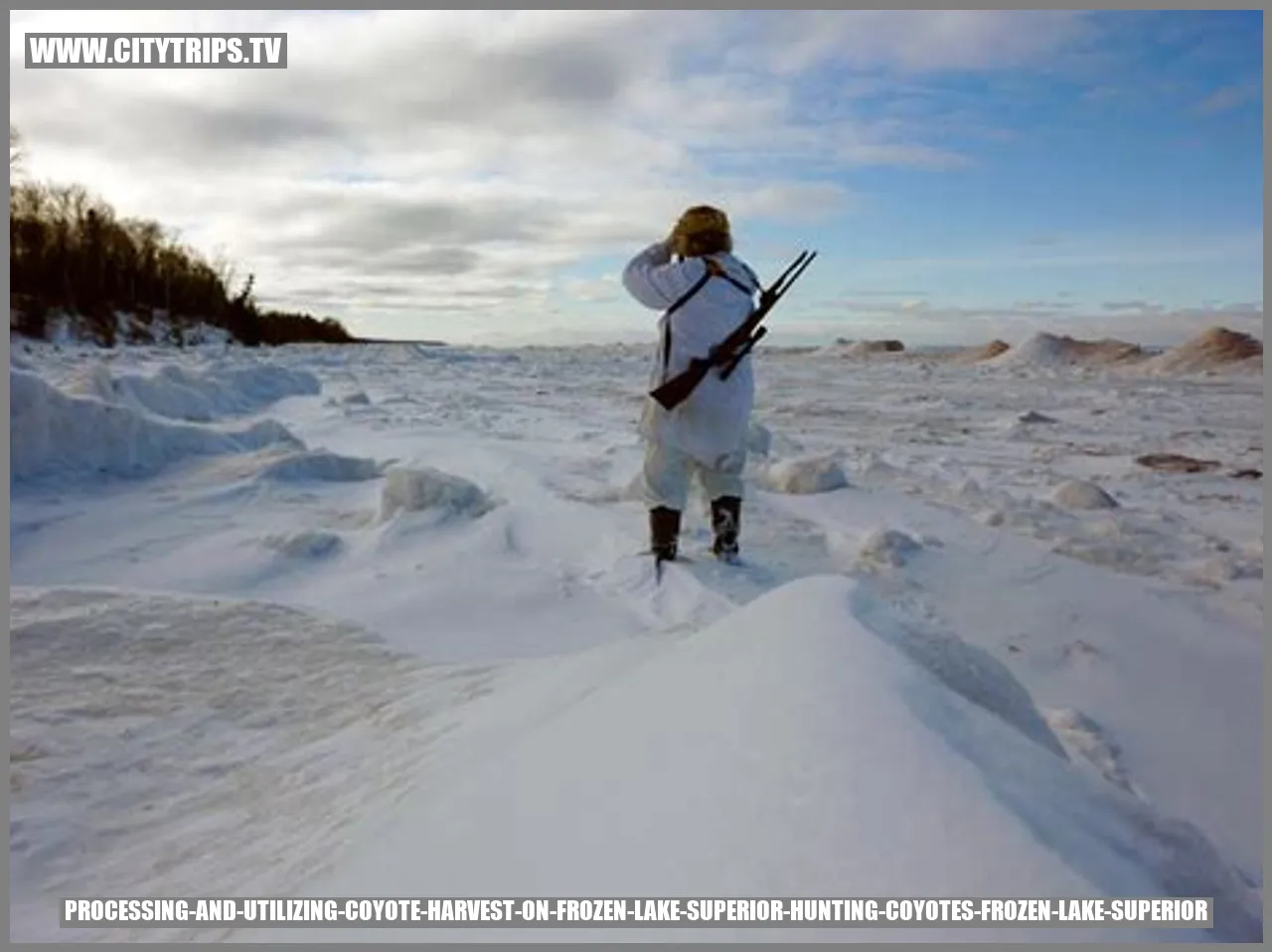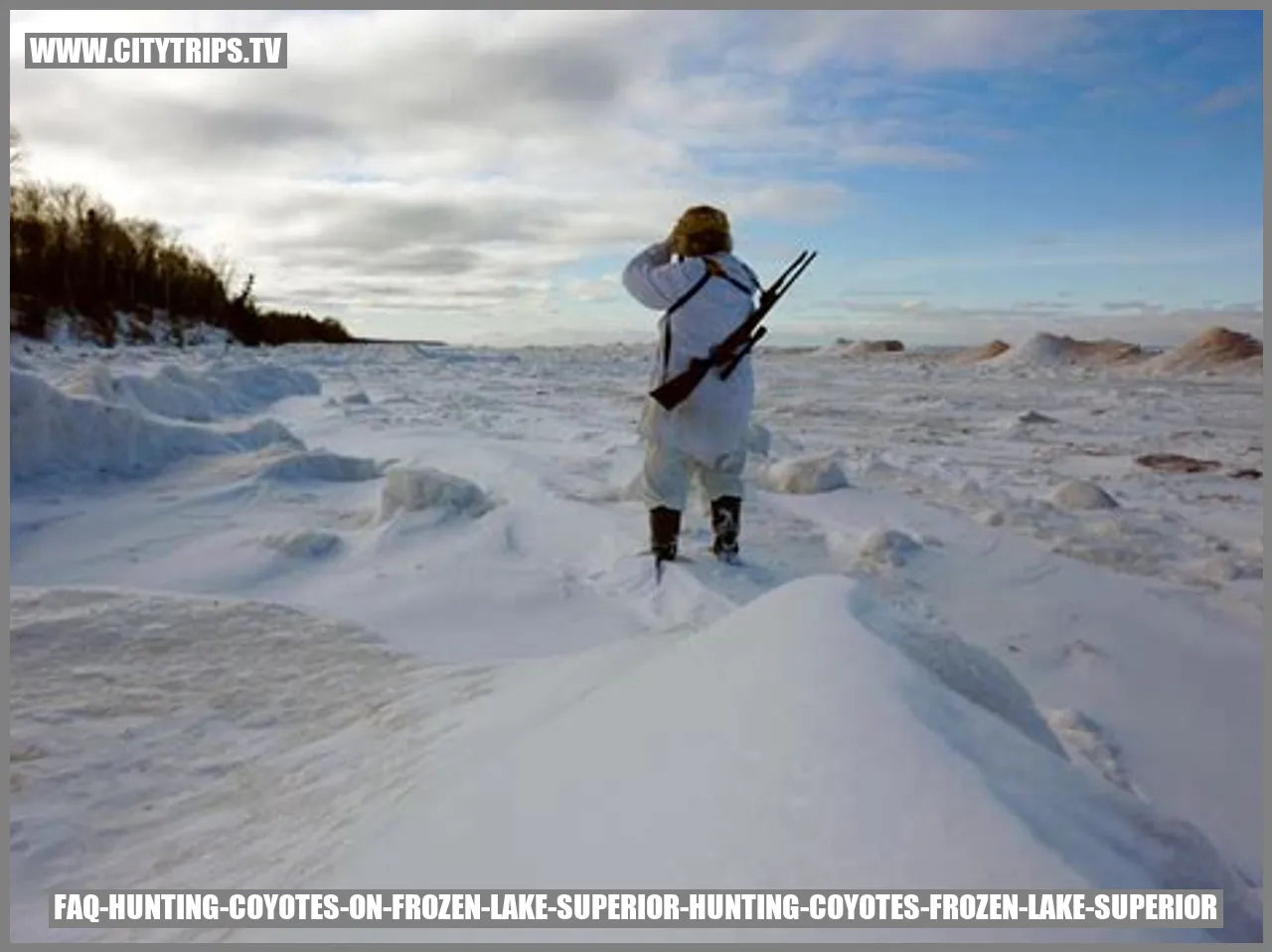Clickbait Heading
: The Excitement of Pursuing Coyotes on Frozen Lake Superior

Sub-Heading
: Optimal Timing for Hunting Coyotes on Frozen Lake Superior
When it comes to hunting coyotes on Frozen Lake Superior, choosing the right time is of utmost importance. The winter months present the perfect opportunity for this exhilarating activity. During this time, the lake freezes over, creating an ideal environment for hunting coyotes. Besides, the abundance of snow simplifies tracking as it covers the terrain, making it easier to spot their movements. Additionally, coyotes tend to frequent the lake’s shores, increasing the likelihood of successful encounters.
Sub-Heading
: Safety Measures for Hunting Coyotes on Frozen Lake Superior
While engaging in coyote hunting on Frozen Lake Superior can be thrilling, safety should be the top priority. Here are some essential tips to ensure a secure and enjoyable hunting experience:
- Prioritize assessing ice thickness and stability before venturing onto the lake. A minimum of 4 inches of clear ice is required to support your weight safely.
- Equip yourself with adequate cold-weather gear and dress in layers to withstand the extreme conditions.
- Inform someone trustworthy about your hunting plans, including your anticipated return time and the specific hunting area you intend to explore.
- Carry essential safety equipment such as ice picks, a whistle, and a flotation device in case of any unforeseen emergencies.
- Never embark on a hunting expedition alone; having a hunting companion increases safety and provides assistance when needed.
Also read:
Hunter Tags Buck Known for Traveling 18 Miles Every Year
Huks New Gunwale Raingear Collection
Sub-Heading
: Essential Gear for Hunting Coyotes on Frozen Lake Superior
Equipping yourself with the right gear significantly contributes to a successful coyote hunting experience on Frozen Lake Superior. Consider the following recommended essentials:
- A high-caliber rifle with an effective scope for enhanced accuracy at long distances.
- Camouflage attire to blend seamlessly with the natural surroundings, improving your chances of staying concealed.
- Cold-weather boots with excellent traction to navigate the icy terrain securely.
- A reliable GPS device or compass to guide you through the frozen lake, ensuring you stay on the right track during your hunt.
- Predator calls and decoys to imitate distressed or mating sounds, attracting curious coyotes and increasing your chances of successful encounters.
Sub-Heading
: Techniques for Tracking and Approaching Coyotes on Frozen Lake Superior
Tracking and approaching coyotes on the icy expanse of Frozen Lake Superior require a strategic approach. Enhance your hunting experience by utilizing the following techniques:
- Look for distinctive tracks in the snow and follow their trail to locate areas with active coyote movement patterns.
- Employ predator calls to replicate distress or mating calls, capturing the attention of nearby coyotes, and enticing them to investigate your location.
- Strategically position decoys to create an authentic hunting scenario, attracting coyotes and increasing the likelihood of successful encounters.
- Maintain a low profile and move stealthily to avoid alerting coyotes to your presence, increasing your chances of getting closer without being noticed.
- Patience is key; find a concealed spot and wait patiently, allowing the coyotes to approach closer before taking precise shots.
Sub-Heading
: The Significance of Proper Disposal of Coyote Remains on Frozen Lake Superior
After a fruitful hunting expedition, the responsible handling of coyote remains becomes crucial. Demonstrate respect for the environment and other wildlife by properly disposing of the remains. Ensure they are buried away from the frozen lake to prevent any potential contamination and maintain a healthy ecosystem within Frozen Lake Superior.
![]()
Cracking the Code: Investigating Coyote Behavior on Frozen Lake Superior
Unlocking the Secrets: Understanding Coyote Habits and Territories on the Ice
Unraveling the intricate web woven by coyotes on the frozen expanses of Lake Superior during the frosty winter months is a task that requires diligent observation and a deep understanding of their behaviors and territorial instincts. Knowing what to look for is the key when tracking these elusive predators on the icy landscape of the lake.
During the winter season, coyotes are known to dwell in the vicinity of the lake’s shoreline, utilising the frozen water as a catalyst to navigate the vast stretches of ice. They carve out territories that provide them with abundant prey and cover, consisting mainly of small mammals like mice, voles, and rabbits, as well as fish that become ensnared in the icy depths of the lake.
If successfully tracking coyotes on frozen Lake Superior is your aim, keeping an eye out for tell-tale signs such as footprints, droppings, and markings on the ice will prove invaluable. Coyote footprints are distinctive due to their X-shaped imprints and claw marks, guiding your steps towards their dens, often concealed in natural havens such as rock formations or fallen trees.
Nature’s Clues: Signs to Uncover when Pursuing Coyotes on the Frozen Lake Superior
Beyond the tracks, other subtle indicators can provide vital evidence of coyote presence on frozen Lake Superior. Scan the ice for scat, a dark-colored calling card peppered with remnants of their diet, such as fur and fragments of bone. Additionally, pay heed to markings etched on the ice’s frigid surface, where coyotes have strategically marked their territory through urination.
Furthermore, keep a watchful eye on any disturbed patches of snow or ice, as these might indicate coyotes digging through the layers in search of sustenance or creating a cozy haven for themselves. These signs offer a window into their behavior, enabling you to anticipate their movement patterns and greatly enhance your chances of successful tracking.
The Path Less Traveled: Factors Impacting Coyote Roaming on Frozen Lake Superior
Various factors exert influence over coyote movements on the frozen expanse of Lake Superior. One pivotal aspect is the availability of prey. Coyotes are cunning hunters, choosing territories teeming with abundant food sources, such as areas with thriving populations of small mammals or fish entrapped in the icy lake.
Weather conditions also play a significant role, dictating the activity level of coyotes. They tend to be more active during calm winter days when winds are gentle, as this allows them to utilize their energy efficiently while navigating the slippery ice. Conversely, harsh weather conditions, like heavy snowfall or strong winds, might restrict their movement and drive them to seek refuge.
Calling all Hunters: Employing Calls and Decoys to Entice Coyotes on Frozen Lake Superior
To entice coyotes on the frozen expanse of Lake Superior, implementing calls and decoys can prove highly effective. Coyotes are social creatures, often lured by the sound of distressed prey or the howls of rival coyotes, arousing their curiosity and drawing them closer.
When choosing calls, opt for those that mimic the cries of injured small mammals or replicate the resonant howls of fellow coyotes. Position decoys strategically to create a lifelike simulacrum, multiplying the chances of attracting coyotes to your location.
Mastering the Art of Surprise: Tips for Crafting an Effective Ambush for Coyotes on Frozen Lake Superior
An ambush can be a fruitful tactic to capture coyotes on the frozen terrain of Lake Superior. To construct an effective ambush, consider the following tips:
1. Seek out locations with ample natural cover, like thick vegetation or rocky outcrops, allowing you to cloak yourself from the acute senses of these sly creatures.
2. Position yourself downwind from the expected route coyotes may take, minimizing the risk of your scent betraying your presence.
3. Utilize natural or artificial elements, such as fallen trees or snowdrifts, to create a camouflage hideout concealing your position while granting a clear line of sight to anticipate coyote movements.
4. Exude patience and maintain a hushed demeanor. Coyotes are cautious beings, easily spooked by sudden movements or loud noises.
By employing these tips and combining them with an in-depth understanding of coyote behavior on frozen Lake Superior, you can exponentially increase your chances of witnessing and tracking these captivating creatures within their icy domain.

Preparing for a Winter Coyote Hunt on Lake Superior
Checking Local Regulations and Obtaining Hunting Permits on Frozen Lake Superior
Prior to embarking on a coyote hunt on the frozen expanse of Lake Superior, it is imperative to review and adhere to the local hunting regulations and licensing requirements. To gain a comprehensive understanding of the specific hunting guidelines enforced in the area, it is advised to contact the relevant authorities or visit the local Department of Natural Resources website. Ensure that you have procured the necessary licenses and permits to avoid any legal complications or penalties during your hunt.
Selecting Appropriate Attire and Equipment for a Winter Hunt on Lake Superior
Coyote hunting on the frigid expanse of Lake Superior can pose unique challenges attributed to its harsh weather conditions. Donning suitable attire is paramount to ensuring both comfort and safety throughout your hunt. Consider layering your clothing to effectively trap and insulate body heat. Opt for moisture-wicking base layers, insulating mid-layers, and waterproof outer layers. Additionally, equip yourself with insulated boots, warm gloves, and a well-fitted hat. Remember to procure the necessary hunting gear, including a reliable rifle, ammunition, binoculars, and a high-quality coyote call for optimal hunting efficacy.
Devising an Effective Hunting Strategy for Winter Coyotes on Lake Superior
Achieving success in your quest to hunt coyotes on Lake Superior during the winter necessitates meticulous planning and strategic thinking. Familiarize yourself with the topography of the area, including significant terrain features and favored coyote habitats. Study their behavior patterns, dietary preferences, and hunting techniques to identify prime locations for setting up your hunt. Take into consideration variables such as wind direction, camouflage effectiveness, and shooting positions to maximize your chances of spotting and successfully capturing coyotes. Thoroughly developing a comprehensive hunting strategy will significantly enhance your overall hunting experience.
Awareness of Potential Hazards and Emergency Preparedness on Frozen Lake Superior
When venturing onto the frozen expanse of Lake Superior for a winter coyote hunt, it is essential to remain vigilant of potential hazards and be adequately prepared for unforeseen emergencies. Regularly assess the thickness of the ice to determine its safety for travel and equip yourself with ice picks or ice cleats for enhanced traction. Stay alert to changing weather conditions and the potential onset of sudden storms. Prior to departure, ensure someone is aware of your hunting plans and provide them with an estimated return time. Prepare a well-stocked emergency kit, including a first aid kit, survival gear, and a reliable means of communication, to effectively respond to any unexpected situations.
Understanding the Ecosystem and the Impact of Winter Coyote Hunting on Lake Superior
Familiarizing yourself with the local ecosystem and comprehending the impacts of winter coyote hunting on Lake Superior are fundamental to responsible hunting practices. Educate yourself about the ecological dynamics, prey population dynamics, and coyotes’ role within the ecosystem. Acknowledge the significance of sustainable hunting approaches that prioritize wildlife conservation. Ensure compliance with established bag limits, report your hunting activities as required, and actively contribute to ongoing research or management initiatives. By displaying respect for the environment and its wildlife, you contribute to the overall ecological balance of the region.

Discover the Secrets of Processing and Utilizing Coyote Harvest on Frozen Lake Superior
Mastering the Art of Field Dressing and Skinning Coyotes on Frozen Lake Superior
Embarking on a coyote hunting expedition on the frozen Lake Superior requires a keen understanding of proper field dressing and skinning techniques. Ensuring freshness and minimizing contamination, field dressing involves meticulously removing the coyote’s internal organs. Skinning, on the other hand, demands careful extraction of the coveted fur. Both of these crucial steps play a pivotal role in preserving meat quality and optimizing the fur’s value.
Safeguarding Quality: Storing and Preserving Coyote Pelts on Frozen Lake Superior
Once the coyotes are skillfully skinned, the correct storage and preservation methods are crucial. A meticulous removal of excess fat or flesh from the fur side of the pelt marks the first step. Proper stretching and drying techniques in a cool, well-ventilated area ensure optimal preservation. These practices ensure that the pelts remain in peak condition, ready to be transformed into beautiful crafts or traded for considerable worth.
A World of Culinary Delights: Exceptional Approaches to Processing Coyote Meat on Frozen Lake Superior
Embracing the full potential of the coyote harvest sets responsible hunters apart. An array of preparation techniques exists, ranging from freezing to canning, enabling long-term preservation of the meat. Moreover, utilizing this exceptionally tender meat to create mouthwatering sausages, jerkies, or incorporating it into creative recipes has become increasingly popular. With such culinary exploration, no morsel of this precious harvest goes to waste.
Unleashing Creativity: Harnessing Coyote Parts for Crafts and Beyond on Frozen Lake Superior
The coyote’s bounty stretches beyond mere fur and meat; resourceful artisans tap into endless possibilities with its various parts. The versatile bones have found purpose in the crafting realm, being shaped into tools, ornate jewelry, and exquisite decorative items. Beyond this, imaginative creators sculpt unique masterpieces utilizing teeth and claws. By unlocking the potential of every component, hunters ensure sustainable utilization and honor the animal’s spirit.
A Return to the Earth: Responsibly Disposing of Unused Coyote Materials on Frozen Lake Superior
The journey towards respect for our environment entails the responsible disposal of unused coyote materials. Honoring ethical principles, this involves proper management of internal organs, bones, and other unusable parts. Adhering to local regulations and guidelines, hunters diligently ensure that no harmful waste is left behind on the beautiful frozen expanse of Lake Superior. By harmonizing with nature, they contribute to its preservation for generations to come.

FAQ – Hunting Coyotes on Frozen Lake Superior
When is the ideal time to hunt coyotes on Lake Superior?
The optimal period for hunting coyotes on Frozen Lake Superior is during the winter season when the lake surface is frozen solid. This typically falls between the months of December and March. Due to limited food availability during this time, coyotes are more active, making them easier to track and hunt.
What are the legal prerequisites for hunting coyotes on Frozen Lake Superior?
Before engaging in coyote hunting on Frozen Lake Superior, it is essential to be familiar with the legal requirements. These may differ based on specific locations, so it is crucial to consult with the local wildlife department or regulatory agency. Generally, hunters must possess a valid hunting license, adhere to designated hunting seasons and limits, and comply with additional regulations such as the use of non-toxic ammunition.
What safety measures should be taken when hunting coyotes on Frozen Lake Superior?
When pursuing coyotes on Frozen Lake Superior, several safety precautions should be taken into consideration. Firstly, it is imperative to inform someone of your hunting plans and expected return time. Additionally, dress appropriately for the cold weather, carry essential survival gear, and exercise caution while traversing the frozen lake. Hunting in pairs or groups is recommended for heightened safety, and avoiding areas with thin ice or open water is necessary.
Which calls and decoys are most effective for attracting coyotes on Frozen Lake Superior?
To entice coyotes on Frozen Lake Superior, using appropriate calls and decoys can prove to be effective. Popular calls include distress calls like rabbit or rodent distress, imitating the sounds of injured prey. Electronic calls are available, producing realistic sounds to lure coyotes. Decoys, such as coyote replicas or motion decoys, can also be used to pique their curiosity and draw them closer.
Is it safe to consume the meat of a coyote hunted on Frozen Lake Superior?
While it is technically possible to consume the meat of a coyote, it is generally not recommended. Coyotes are opportunistic scavengers, and their diet often consists of carrion and other animals. Consuming their meat can pose health risks due to potential transmission of diseases and parasites. It is advisable to focus on the hunting experience and observing coyotes rather than consuming their meat.
How should coyote remains be properly disposed of after a hunt on Frozen Lake Superior?
After a successful coyote hunt on Frozen Lake Superior, it is vital to appropriately dispose of the remains. It is recommended to follow local regulations and guidelines for the disposal of animal carcasses. This may include burying the remains at an adequate depth or seeking guidance from local authorities on proper disposal methods. It is crucial to prioritize responsible and ethical practices when handling and disposing of coyote remains.
What is the ecological impact of coyote hunting on the Frozen Lake Superior ecosystem?
Coyote hunting on Frozen Lake Superior can have various effects on the ecosystem. By controlling the coyote population, a balanced ecosystem can be maintained, as coyotes can significantly affect prey populations. However, responsible hunting practices must be employed to ensure the preservation of ecological balance. Overhunting or targeting specific age groups or genders excessively can disrupt natural dynamics and potentially have unintended consequences in the ecosystem.

